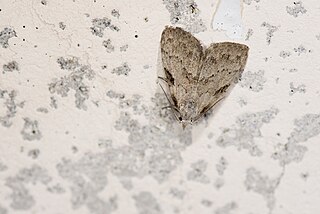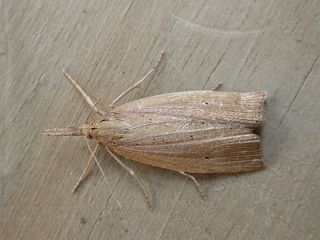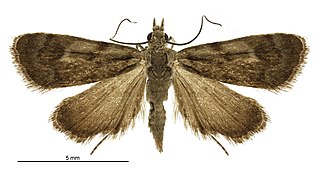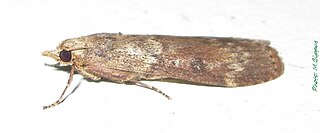
Utetheisa is a genus of tiger moths in the family Erebidae. The genus was first described by Jacob Hübner in 1819.

Crambinae is a large subfamily of the lepidopteran family Crambidae, the crambid snout moths. It currently includes over 1,800 species worldwide. The larvae are root feeders or stem borers, mostly on grasses. A few species are pests of sod grasses, maize, sugar cane, rice, and other Poaceae. The monophyly of this group is supported by the structure of the tympanal organs and the phallus attached medially to the juxta, as well as genetic analyses.

Aemene is a genus of moths in the family Erebidae first described by Francis Walker in 1854. They are found in Japan, throughout India, Myanmar and Sri Lanka.

Manoba is a genus of moths in the family Nolidae. The genus was first described by Francis Walker in 1863.

Ancylolomia is a genus of moths of the family Crambidae described by Jacob Hübner in 1825.

Calamotropha is a genus of moths of the family Crambidae.
Charltona is a genus of moths of the family Crambidae. The genus was erected by Charles Swinhoe in 1886.

Chilo is a genus of moths of the family Crambidae. Some of these moths are called borers.

Culladia is a grass moth genus of subfamily Crambinae, tribe Crambini. Some authors have assigned the synonymous taxon Nirmaladia to the snout moth family (Pyralidae), where all grass moths were once also included, but this seems to be in error.

Glaucocharis is a genus of moths of the family Crambidae first described by Edward Meyrick in 1938. The type species for this genus is Glaucocharis stella.
Mesolia is a genus of moths of the family Crambidae described by Émile Louis Ragonot in 1889.

Paracymoriza is a genus of moths of the family Crambidae.
Ramila is a genus of moths of the family Crambidae.
Surattha is a genus of moths of the family Crambidae. The genus was synonymized with Prionapteryx by Stanisław Błeszyński in 1967. Its status was later revised by Graziano Bassi and Wolfram Mey in 2011.

Scirpophaga is a genus of moths of the family Crambidae described by Georg Friedrich Treitschke in 1832. Asian species include significant rice stemborer pests.

Euproctis is a genus of tussock moths in the family Erebidae described by Jacob Hübner in 1819. Species are cosmopolitan, widespread throughout Palearctic, African, Oriental and Australian regions. Molecular phylogenetic studies indicate that the genus as presently understood comprises a large number of unrelated lineages, only a few of which have names, and is therefore in serious need of revision.

Derambila is a genus of moths in the family Geometridae first described by Francis Walker in 1863.

Ozola is a genus of moths in the family Geometridae first described by Francis Walker in 1861.

Sauris is a genus of moths in the family Geometridae erected by Achille Guenée in 1857.

Lamoria is a genus of small moths belonging to the family Pyralidae.














